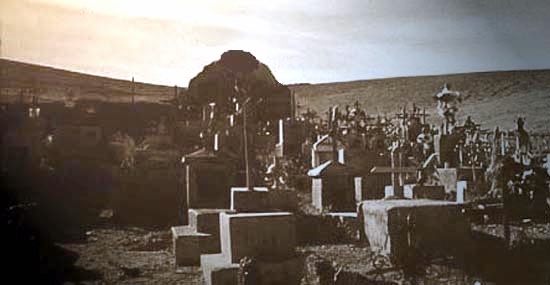
San Vicente Cemetery
Some contend that after Sundance died in the house in San Vicente, Butch sneaked out in the dark of night and ultimately returned to
the United States. Various "Butch sightings" were reported from 1910 to 1941.
Others contend that it has simply not been proven that the two killed in San Vicente were Butch and
Sundance. It is contended at least some of the "sightings" prove that it could not have been the
two. Other locations for a death of the two in South America have been put forth. A death of the
two in 1911, may be confusion with the death of Evans and Wilson noted on the
previous page. Based on Anselm Verener Lee Guise's 1922 book, Six Years in Bolivia: The Adventures of a Mining Engineer,
it has also been suggested that the two were killed in
Cochabamba, Bolivia. Guise wrote:
"A railway construction camp, particularly in a new country, as a rule
harbours several men into whose past inspection is not invited by them,
and the Patacamaya camp was no exception in this respect. There was one
man in particular - a 'gang-boss' and a particularly evil looking
individual - who was reputed to the sole surviving member of the 'Hole in
the Wall' gang, which, at one time, had been infamous in the Western States
of America for its many 'hold-ups' and murders. The existence of the gang
was finally terminated by the sudden deaths of most of its members, either
as the result of collisions with the sheriff's posse, or through the medium
of a rope. This man, who went under the name of Grogan, had made good his
escape from the States, and it is said that there was a price on his head
of five thousand dollars."
Guise then recounts that Grogan disappeared with three other men in conjunction
with the payroll robbery of $10,000.00 from another camp about
15 miles away.
Guise continues:
"Two of these bandits were discovered later in Cochabamba, a town which
lies eighteen leagues to the north-east of Oruro. They were both shot
dead in an affray with Bolivian soldiery who had attempted to arrest them.
Grogan, however, was not one of these."
As to the "Butch Sightings," Anne Meadows in Digging up Butch and Sundance,
St. Martins Press, writes that unverifiable reports have Butch:
asking a postal detective in Salt Lake City to buy a wagon, harness, and
camping outfit for him with money he peeled from ‘a big roll of bills' in
1910; saving Jesse James's grandson ‘from five kidnappers in the St. Louis
railroad station,' after receiving a coded telegram about the plot while
getting a medical checkup in a nearby hospital; then returning to Utah to
work in a saloon in Price in 1915 and to sell shoes in Delta in 1918.
Later, he supposedly went to Wyoming and spent two days in Baggs, drank
whiskey in a Lander bar, looked up an old flame, and had his Model-T Ford
repaired in Rock Springs, while hauling around a two-wheel trailer full of
camping gear. He also attended a Wild West show in San Francisco; prospected
with Wyatt Earp in Alaska; popped up in Nogales, Arizona; visited
Albuquerque, New Mexico, and drifted to Europe.
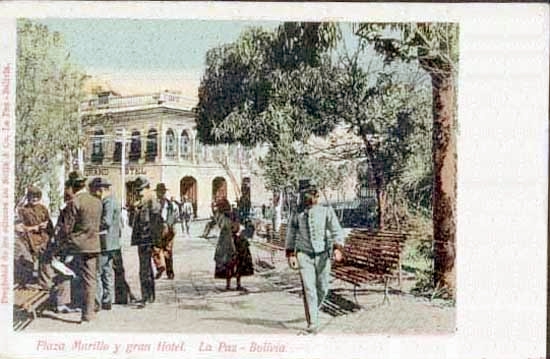
Gran Hotel, LaPaz approx. 1908.
Some of the sightings can undoubtedly be attributed to former unsuccessful
Spokane businessman William T. Phillips. There have been unverified accounts that
Phillips may have worked as a bartender in Lander. Indeed, some authorities give the date of
Butch's death as July 20, 1937 (the date of Phillips' death). See Scott A Cupp, Life and Death in the Wild West:
A Necrology published in The West That Was, edited by Thomas W. Knowles and Joe R.
Lansdale, Wings Books, New York, 1993. Phillips claimed to be Butch, but today his
claims have been almost complete debunked. He was the wrong height, weight, and besides, he
was born in Michigan.
Other sightings may be attributed to the fact that five of Butch's brothers were still alive in the
1920's. Thus, there may have been confusion with one or more of Butch's brothers. More difficult are the claims of Lula Parker Bentenson, Butch's sister, who claimed that
Butch, driving a new Ford, visited the family in 1925. She claimed that Butch died in 1937 in Washington State. She denied,
however, that Butch was William T. Phillips. Other members of the family have denied the claims including the
claim as to the arrival of the Ford automobile.
Equally intriquing, but without documentation, is the contention by C. F. Eckhardt, Tales of Badmen, Bad Women and
Bad Places, p. 144:
"There are historical indications that
Butch Cassidy--or somebody who looked and acted
almighty like him and knew a lot about him --
was managing a ranch in Sonora, Mexico, as
late as the late 1920's. There's even a
photograph of a feller who mightily resembles
Butch Cassidy, which is known to have been
taken on that ranch about 1923."
_____________________
Milt Hinkle
Milton David Hinkle (1881*-1972) [*See text below], an early bulldogger and rodeo showman, also claimed that Butch and
Sundance did not die in Bolivia as reported. Hinkle claimed to have met Butch and Sundance in Argentina in 1909 and 1913 where Hinkle was
participating in a wild west show.
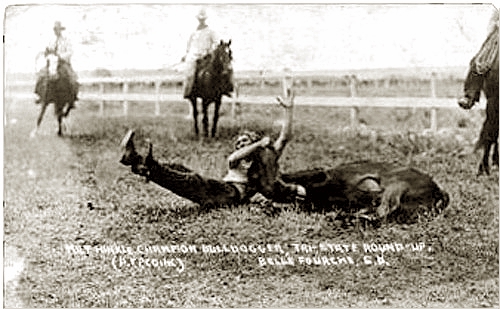
Milt Hinkle, Belle Fourche TriState Rodeo, undated.
Hinkle also described to
western writer Kerry Ross Boren an alleged reunion of sorts held in Argentina in the "mid-1920's" between
Sundance, Kid Curry, Art Acord, Harry Smith and Clay McGonigal [sic]. Supposedly, as a
part of the festivities, and on a dare, a bank was robbed. It is a great story, but with a problem,
rodeo star, Henry Clay McGonagal (1879-1921), an alleged participant in the robbery, had already
gone to the "Big Corral." He was accidently electrocuted on October 24, 1921, on the Pagago Indian Reservation near
Sacaton, Ariz., while moving a downed power line blocking his hay wagon. McGonigal actually went to South
America, but in 1902. Art Acord (1890-1931) was a bulldogger for the Miller Bros. 101 who became a silent western movie
star. Acord, Hoot Gibson, and Tom Mix were all alumni of the Selig Polyscope Co. for whom all played in the
1912 Pride of the Prairie. Acord's career failed due to alcoholism. He was allegedly murdered by an irate husband in
Chihuahua, Mexico in 1931. Mexican authorities, however, listed the death as "suicide." Acord was born in Stillwater, Indian Territory in 1890.
In 1939, Acord's body was returned by Tom Mix to the
United States for interment at Forest Lawn. Acord is frequently shown as having come from Prattsville, Utah. His family had come from
Prattsville. Following, the death of his mother in 1891, the family returned to
Utah.
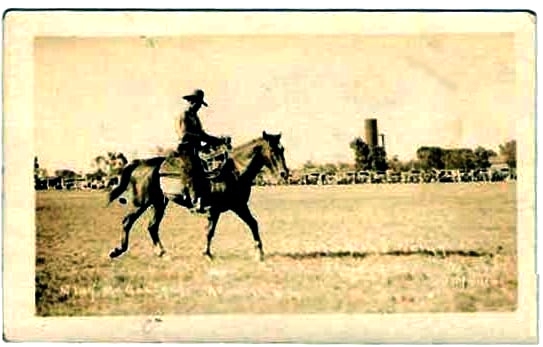
Clay McGonagal, Animas, New Mexico, undated.
It may be speculated that Hinkle's story of the bank robbery in Argentina at the reunion was
inspired by newspaper accounts. As late as the 1920's newspapers were attributing bank robberies
in South America to Butch and Sundance. It may also be speculated that the story told when Hinkle was in his
80's may have been a confusion of events that Hinkle experienced with stories he had heard.
Hinkle's magazine articles were oral accounts taken down by a friend. The
friend then placed them into appropriate format for publication without further research for accuracy.
Thus, errors crept in.
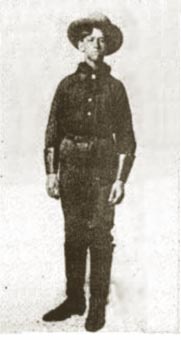
Milt Hinkle, approx. 1906
Hinkle undoubedly was a larger than life figure but also one who may have exaggerated his life's history.
Exaggeration of one's biography by rodeo participants, however, was not unusual. Tom Mix, himself,
claimed to have been born near El Paso. Mix was in fact born in Pennsylvania. Mix claimed to have
been a lawman. He was not. He claimed to have trained horses for the British Army for the
Boer War, to have actually served in South Africa at Ladysmith, and to have participated in the Spanish-American War in the
Philippines. He did none of these things.
In the same manner, Hinkle embellished his life's history. Hinkle claimed that he was born in Bovina, Texas, on Oct. 15, 1881, the son
of Ford County, Kansas, lawman George T. Hinkle. George T. Hinkle, however, was married to Annie C. Hinkle and was living in
Dodge City at the time. Hinkle later suggested that he may have been the product of his father having
multiple women. Bovina was not settled until the late 1880's when the railroad
came through and a shipping station for the XIT Ranch was established. Prior to the founding of
the XIT, the area had zero population, nada. Hinkle claimed that at some point he was
employed by the XIT [Writer's note: Hinkle's death certificate reflects that he was
born in Texas but fails to give city or county of birth. World War I draft registrations for Parmer County, Texas, in which Bovina is located, show Hinkle
to have been born in Little Rock, Arkansas, on 15 Oct. 1888.]
Shortly after Hinkle's birth, Milt moved to Fort
Smith, Arkansas where he lived with his mother Lulu Hinkle. Hinkle's death certificate indicates that his mother's
name was "unavailable." At age 15, Hinkle was on his own and
participating in wild west shows. Thus, Milt was in some of the same shows as the leading performers of the
time including Bill Pickett, Lulu Parr, and Buffalo Bill Cody. At some point, he joined the Milller Bros. 101. As above-indicated,
Hinkle claimed that he met both Butch and Sundance at the 1904 St. Louis World's Fair, and later met Butch and
Sundance in South America in 1909 and 1913. Hinkle, in fact, traveled to South
America in both years. Upon his return from Argentina, Hinkle worked the
rodeo circuits under the name "The South American Kid."
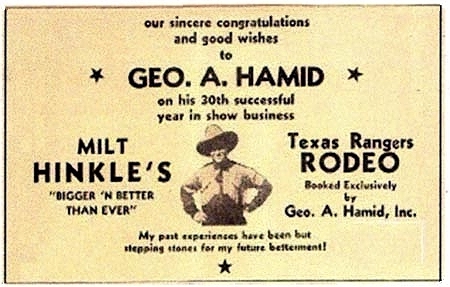
Advertisement for Texas Rangers' Rodeo, 1937
George A. Hamid (1896-1971) received his start at age 9 as an acrobat for Buffalo Bill's Wild West then
performing in France. Hamid in the 1930 became the largest booking agent for
circuses and similar acts. He owned the New Jersey State Fair and presented the
Cirque Parisienne at the 1939 New York World's Fair. He later acquired the
Atlantic City Steel Pier. The Hamid-Morton Circus remains in business, now operating the
annual Shrine Circus.
By 1920, Milt, then living in Rising Star, Texas, was participating in rodeos with Mildred Hinkle.
He became an independent rodeo producer but went broke and ended up in
California. There, he wrestled and boxed. Among those with whom he later claimed to have boxed was
Max Baer. If so, Baer (1909-1959) would have
had an advantage of age. Baer's professional career started in 1929 at age 20 when
Hinkle would have been 48 years old. Additionally, a review of a list of all of
Baer's professional bouts fails to reflect Hinkle. In the 1930's Hinkle was again a
rodeo producer. He produced the Texas Rangers Rodeo which performed at, among other places, the
Boston Garden.
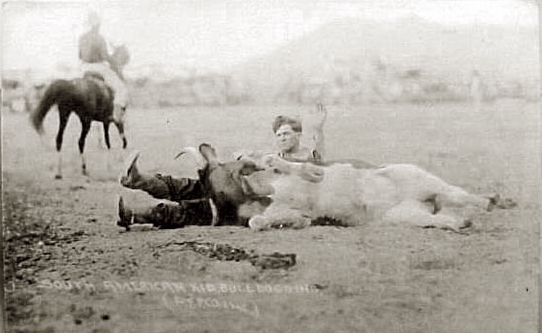
Milt Hinkle, bulldogging, undated. Photo by Ralph Doubleday.
Hinkle also claimed that he served as body guard for Theodore Roosevelt, and was a friend of Bat Masterson and Wyatt Earp.
According to Charlie Carlson as quoted by Jim Robison [Orlando [FL] Sentinel,
"Osceola Cowboy rode with Butch Cassidy," July 18, 2004], Hinkle as a bulldogger attempted
to bulldog a steer in 1931 by diving from a low flying airplane. Hinkle broke his hip. The
steer was killed. According to western writer Kerry Ross Boren, this astounding
feat was made in support of Pancho Villa. Villa, however, was killed in
1923. Hinkle's credibility has been questioned by others. As a writer for
western pulp magazines, Hinkle had a tendency to prevaricate.
Another western writer, Gene Bell,
cites as an example Hinkle's description of
Tom Mix:
No man ever lived who more thoroughly defied psychoanalysis than Thomas Arthur Leventhau
later to be known as Tom Mix. His father was a miner of Jewish, Italian, and French
Canadian extraction. Elizabeth, his mother, was of gypsy descent.
Tom’s birthplace was not far from DuBois, Pennsylvania; his birth date about
1878 or ‘79. Tom was about two years old when his father died. His mother then
married Ed Mix, a Greek cab driver of horses who worked for
John E. DuBois in 1989 [sic]."
About the only thing true in the above statement was that Mix was born in Pennsylvania.
Hinkle's reputation as a showman was also suspect and was known to many early rodeo participants as a
"bloomer," that is, a rodeo promoter who would promise great things to rodeo cowboys, but at the
end of the show would stiff the poor cowboy of his purse. Indeed, writer Bill King crowned
Hinkle as the "king of the run out boys."
By the late 1940's, Hinkle was producing rodeos in the then small Florida cowtown of Kissimmee. In one
of his shows Zach Miller, the last of the Miller Brothers, made an appearance. In the
1960's, Hinkle was writing for western pulp magazines. Hinkle's claims as to meeting Butch and
Sundance in Argentina cannot, however, be totally dismissed out-of-hand. Hinkle in his claims mentions
Andrew Duffy. The claims were made prior to investigations by others revealing that there was in
fact a Duffy in Argentina. Duffy is not mentioned, as an example, by Charles Kelly in his The Outlaw Trail.
Thus, if Hinkle did not have first hand knowldge, the question must be
asked, how did Hinkle know of Duffy?
But if Milt led writers and historians down
false trails through his embellishment or egaggeration, he may be forgiven. In the late 1960's, a young boy whose father had repaired
Milt's aged, salmon-colored automobile, befriended Milt. In Kissimmee, Milt was living in a modest house
on a dirt road. The two would go to the parking lot of a local super market where Milt would attempt
to hawk his magazine articles. A sign on the roof of the car would invite passersby to shake the
hand of the man who had shaken hands with Wyatt Earp. Somehow, the old cowboy found the money to
buy the young boy a pony. The boy's parents had no place to keep the pony so it was pastured in their
front yard in a single-family neighborhood. Yet, the neighbors did not complain. In 1972, Milt Hinkle
crossed the Great Divide at age 90 following an
automobile accident. The boy, too, has now crossed the Great Divide. Perhaps, as is the cowboy in
the old Sons of the Pioneers song, they are together "herding stars with Buffalo Bill."
______________________
In 1991, an effort using DNA evidence was made at proving the identity of the
two in San Vicente. Bones were excavated. Unfortunately, the only bones that were examined proved to be those of
German mining engineer who died subsequent to the incident in San Vicente. The bones of the
two desconcides remain just that, unknowns.
And what of Harvey Logan, "Kid Curry," with whom we began on a preceeding page? In 1901, Logan participated in the
robbery of the Great Northern Express. In the fall of that year, Logan, going by the name of
William Wilson appeared
in Knoxville, Tennessee. There, he residing in a downtown parlor house. As noted on a previous page, a brigand by the
name of William Wilson was killed in South America in 1911. That Wilson, however,
is believed to have come from Montana. As also observed previously, Logan had a bit of a temper. While
playing pool at Jones Pool Hall, Logan got into an alteration with Luther Brady. In the fray, Logan
strangled Brady, shot Jim Boley who had attempted to come to Brady's rescue. Additionally, he
shot two police officers who had responded to a summons by patrons of the Pool Hall.
Logan escaped. He was recognized two days later and taken into custody. Moneys from
the Wagner robbery were recovered. Based on the presence of indentical past wounds to the wrist from the capture in Lavina, Montana,
and buckshot wounds received in the robbery of the Shankersville, Wyoming, Hog Ranch, Logan was positively identified by Pinkerton agent Lowell
Spence.
Logan was tried in Knoxville for passing stolen notes and convicted. Yet on June 27, 1903, he escaped.
Logan was seen passing through several small towns in North Carolina. There were reports that
Logan had been seen in Montana. On June 7, 1904, a Colorado Midland train was anticipated to pass near the
small town of Parachute, Colorado. The train bore a sizable payload in the Wells-Fargo safe within the
express car. In Parachute, Colorado Midland and Denver & Rio Grande tains used for a
short distance the same tracks. A westbound train appeared, paused to discharge a passenger and then as the train crawled up
the hill to the west of town, engineer Ed Allison observed someone hopping on the train. The enginner instructed his fireman,
John Anderson, to go back and remove the new passenger from the train. Anderson, however, was greeted
by a six-shooter. At gunpoint, Anderson, accompanied by the new passenger, proceeded to the
locamotive where Allison was instructed to bring the train to a halt at Streit's Flat about three miles to the west
of Parachute. There, two more men boarded the train and disconnected the passenger cars. The locomotive, tender and
express car then proceeded further up the track and was brought to a halt near where the
robbers had secreted a stolen boat. In the meantime, express messenger Daniel
Shea barricaded the door. As in several prior robberies, the door was dynamited. Additional charges were placed next to the
safe. The safe, however, was not a Wells-Fargo safe, but was instead a Globe Express Company safe. The three men had
halted and were robbing the wong train, the Denver & Rio Grande train Number 5 passenger train rather than the Colorado
Midland train. The safe allegedly contained only about
ten dollars.
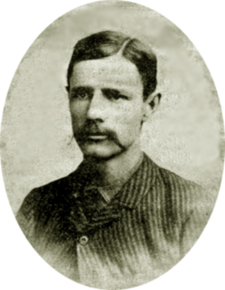 Garfield County Sheriff, Francis W. Adams
Garfield County Sheriff, Francis W. Adams
A Mesa County posse as well as a Garfield County posse led by sheriff Frank Adams trailed the
outlaws to a point on Garfield Creek near Rifle, Colorado. There, trapped and wounded, one of the three, rather than be captured, committed suicide.
the other two robbers managed to escape. Sheriff Adams took the body to Glenwood Springs where
Globe Express agent Otto Barton identified the body as that of J. H. Ross who had shipped a suitcase to
Pueblo a week before. Unfortunately, Ross turned up alive and well in Pueblo. The body, based on
a letter found on the body was then identified as that of Tap Duncan, a relative of Black Jack Ketchum.
The body, placed in a cheap casket, was photographed from various angles. Based on the photographs,
Denver Pinkerton Superintendent James McParland identified the corpse as that of Harvey Logan. The photographs were then
sent to Knoxville, where again the body was positively identified as Logan. William Pinkerton then
sent agent Lowell Spence to Glenwood Springs to disinter the body. On
July 16, Spence, Denver and Rio Grande special agent R. Brunazi, Undersheriff Mohn and Deputy
Crissman, and physicians Clark and McAllister, disinterred the corpse.
After a month, the body was badly decomposed. Spence again identified the remains as that of
Logan, railroad agents demurred. It has been argued that the railroad agents were influenced by the fact that
if the body was that of Logan, large rewards would be due the posses. Notwithstanding, the positive identification by Spense,
McParland and the Knoxville sheriff's office, William Pinkerton reported to the American Bankers Association
that he had doubts. Because of the uncertainty, cemetery records continued to show the grave as that of J. H. Ross.
Several proposals have been made to dig up "Ross" and using DNA determine whether the body is that of
Logan. See Wilson, Gary A., Tiger of the Wild Bunch, Globe Pequet, 2007, p. 204. The same was suggested also
in June 2009 by anonymous commentators to a story "Was Duchesne farmer the Sundance Kid?" in The Deseret News.
The exact location of
the grave is uncertain, cemetery records have been lost and a part of the cemetery was affected by a landslide.
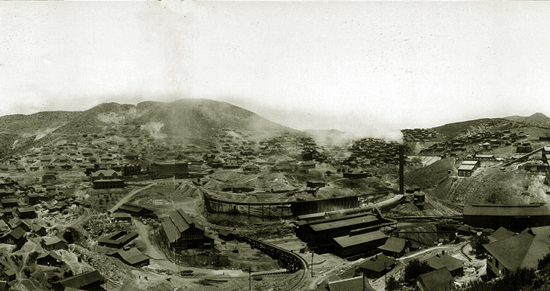
Morenci, Arizona, approx. 1910
Charlie Siringo also believed that the body was not that of Logan. In 1910, the Gila Valley Bank in copper
mining town Morenci, Arizona, was robbed by a
lone gunman. Two weeks after the robbery, Siringo, arrived in Morenci. In searching the hills, Siringo found
two Mexicans. The day before the robbery, they had seen an individual they believed to have been
the robber. Based on their description of the individual, Siringo believed that the robber
was Logan.
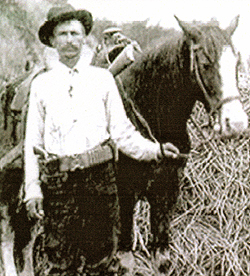 Charlie Siringo
Charlie Siringo
Charlie Siringo later wrote:
In my investigations I found out that just before
this robbery "Kid Curry's" old pal, Bob McGinnis, who had been
pardoned from the penitentiary, had sold his saloon in
Alma and dropped out of sight.
Another old pal, "Butch Cassady [sic], who had formerly run a
saloon in Alma for four years, under
the name of Jim Lowe, was seen
with McGinnis not long before the hold-up."
If the indentification of the remains in Glenwood Springs was in error, what happened to Logan? Whoever it was, the body was assuredly not
that of George Taplin "Tap" Duncan, an Arizona cowboy and rancher. Although Duncan died with his boots on, it was under much
more prosaic circumstances. He was struck and killed by a Ford coupe in
1944 in Kingman, Arizona. It, of course, may be speculated that the body along side the Denver &
Rio Grande tracks might have been a different Tap Duncan. Thus, it will be recalled with regard to
Green River, that there was a Frank Duncan who ran away with
"Madame" Forrestal. Charles Kelly's The Outlaw Trail, Bison Books edition, indexes Frank Duncan as "Duncan, Tap."
The text, however, does not bear out the connection.
According to Milt Hinkle, Andrew Duffy, mentioned above, was in fact Harvey Logan. Hinkle claimed that, as
Duffy, Logan later married and worked as foreman on a ranch owned by an Englishman,
Reginald Casey, and died in 1941 near Bahia Blanca. As previously noted there was an Andrew Duffy who had
appeared in Argentina in 1905. In Chubut Provence there was also a rancher named Edmundo Reginaldo Casey y Browne.
Luis Sepúlveda also believes that Duffy was in reality
Logan.
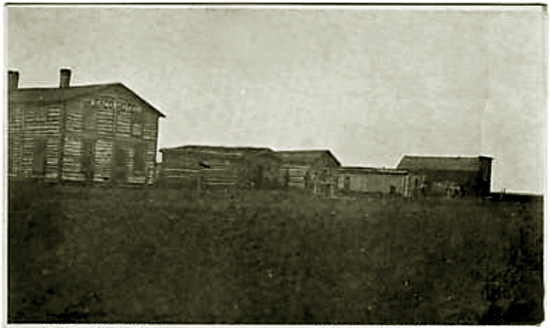
Saco, Montana, 1893.
Most likely, Duffy was a small-time rustler from Montana who, with Ed Shufelt, purchased the Valley Saloon in
Saco, Montana, in 1902, using proceeds from the sale of rustled Montana horses north of the
border in Saskatchewan. Shufelt's interest in the saloon apparently ended when he shot
"Long" Henry Thompson in the back four times. The jury found Shufelt not guilty believing that it
was self defense. Shufelt was ultimately found guilty in Saskatchewan of rustling and died in
prison, a guest of the Crown. It is believed that Duffy was killed in 1910 near the border of Argentina and
Chile by Robert Evans and another English-speaking pistolero, Mansel Gibbon.
Of the remaining Curry's, Lonnie Logan was killed in front of his aunt's residence by a posse at Dodson, Kansas (now a part of Kansas City), on
February 28, 1900. Robert E. "Bob" Lee, aka Bob Curry was sent to prison for passing bank notes
stolen in the Wilcox robbery. Of the Logan brothers, Hank remained honest.
Music this page:
When it's Lamp lighting Time in the Valley
There's a lamp burning bright in a cabin
In a window it's shining for me
And I know that my mother is praying
For her boy she is longing to see
When it's lamp lighting time in the valley
Then in dreams I go back to my home
I can see that old light in the window
It will guide me wherever I roam
In the lamplight each night I can see her
As she rocks in her chair to and fro
Though she prays that I'll come back to see her
Still I know that I never can go
When it's lamplighting time in the valley
Then in dreams I go back to my home
But I've sinned against my home and my loved ones
And now I must evermore roam
So she lights up the lamp and keeps waiting
For she knows not the crime I have done
But I'll change all my ways and I'll meet her
Up in Heaven when life's race is run
When it's lamp lighting time in the valley
Then in dreams I go back to my home
I can see that old light in the window
It will guide me wherever I roam
When It's Lamp lighting Time in the Valley is attributed to Herald Goodman of the Vagabonds
in 1933. It was subsequently performed by, among others, Tex Ritter and Marty Robbins. Like many
old songs there are multiple variations.
|